The following list includes improvements or fixes that enhance existing features and procedures.
Bizagi now offers a new out-of-the-box connector with the SAP Cloud Platform. The Cloud Platform is an integration intermediary with other SAP ERP systems like SAP S/4 HANA, for both on-premises or cloud versions. This extends the usage of SAP systems within your Bizagi intelligent process automation strategy.

We are enriching existing data models by introducing Runtime entities. Runtime entities contain read-only information relating Bizagi’s process and cases internal data, such as case creator, creation date, ongoing Activities, allocation history, transition history, among others.
This information is now available to be easily exposed for Business Insights through the BI connector, to create more powerful reports.
They are also available from Forms, Expressions, Document templates, emails and Connectors.
For Forms a new control has been created: Read-only control.
Now users can create, edit, and test connections to the latest version of the Automation Anywhere control room: A2019. With this, new types of parameters are available for the inputs and the outputs: dictionaries and lists.

Users can now integrate with another type of robot using UiPath: attended robots. These robots will be configured in Bizagi Studio and executed in processes in the Work Portal.

To execute attended bots, users will have the possibility to associate them to buttons in the forms editor.
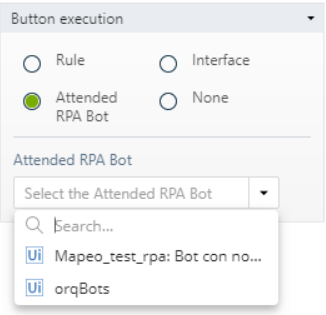
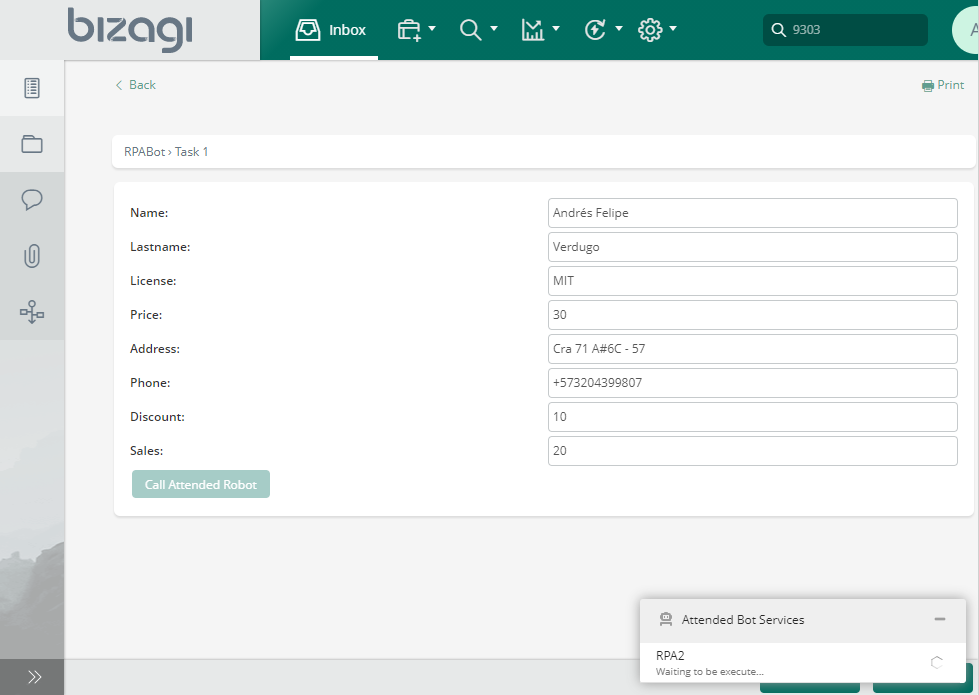
It is important to mention that for these bots to work, it is necessary to configure a content-security-policy parameter in the Custom Parameters of Bizagi Studio or the Management Console Web.

The way of integrating Bizagi with external systems has become easier with the new Integration Hub. All the options available concerning external systems have been centralized. Now, you will be able to import .bizc files, import connectors from Bizagi Xchange and, access to the connector editor in the centralized api Connector option.

Now, additional to importing the .bizc files and the connectors from Bizagi Xchange, you will be able to create REST and custom connectors, as well as import RAML and OpenAPI files directly in Bizagi Studio with the integrated connector editor. It comes with a brand-new feature to test the connectors without having to create a new case in the Work Portal.
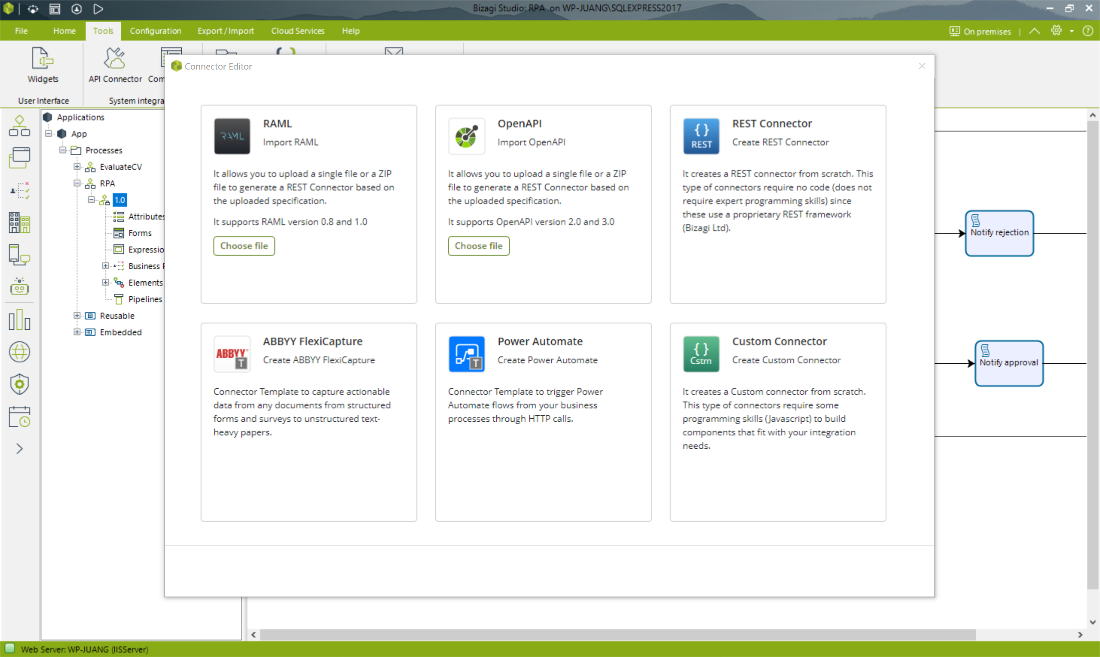
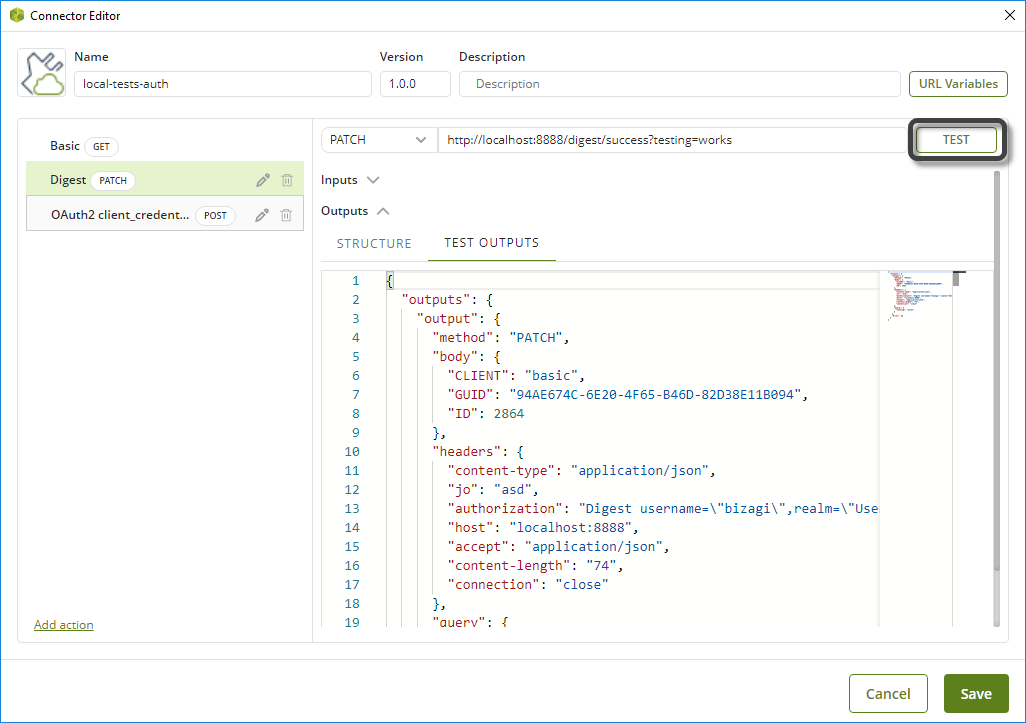
The new Azure – Translate connector allows you to easily translate in real time texts in more than 70 languages.
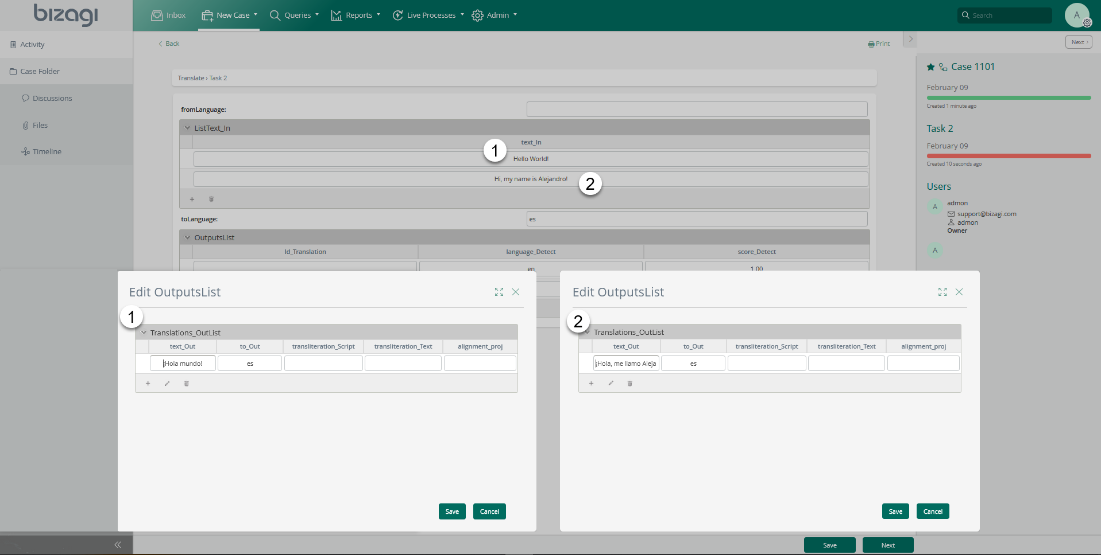
To enable integration with Microsoft Power Automate, the following features have been developed.
Improve your intelligent processes with Bizagi’s new native connector. Use Microsoft Azure Form Recognizer’s swift OCR capabilities to convert images, handwriting or printed documents into encoded text, and integrate this information in your IT systems and processes.
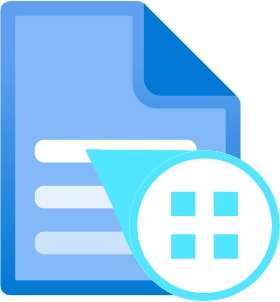
The two new OData endpoints allow users to save the progress of an activity, and to trigger an event from de OData layer. The set event method applies only for intermediate events with no sub type.
You can configure multiple identity providers associated with the authentication of users for cloud-based services and portals. For example, the Customer Portal, Modeler Services, Studio Collaboration servicers, and AI or BI portals.
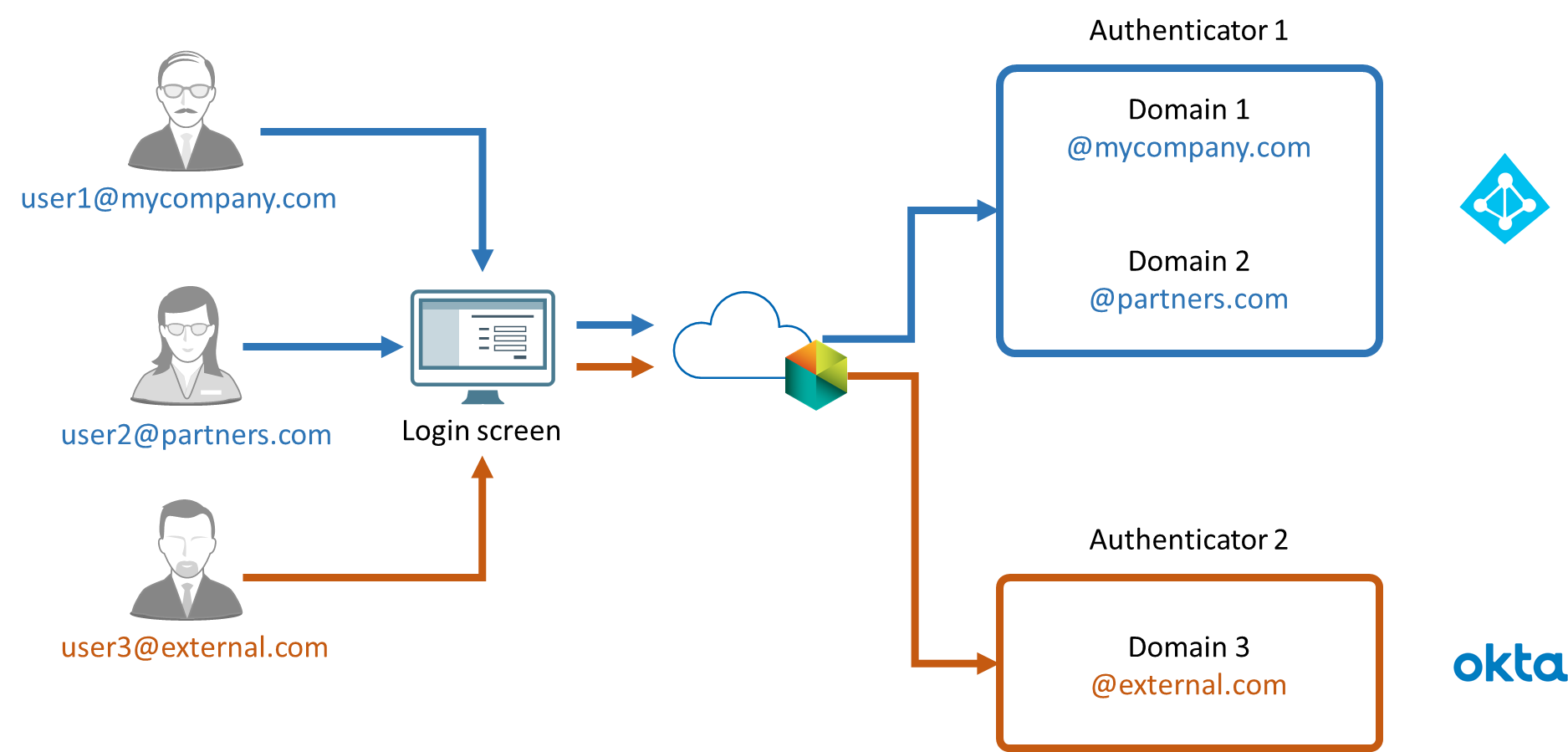
Improvements were made in the database structures, for both SQL and Oracle engines, to reduce the time when executing deployments and importing tasks.
The analyzer did not detect dependencies when a string was concatenated in a parameter that expected an XPath, for example:
var filter = "sCaseNumber = 1";
var result = Me.getXpath("entity-list('M_A_Details',"+filter+")");
Now, the variable concatenated in the filter is detected by the Dependency Analyzer.
New functions have been included in the Command Line deployment utility. These functions perform ost common operations after the deployment, such as stopping and starting the scheduler, creating database and Web App backups, cleaning temporary files and more.
A deployment is mainly divided into two steps: export a deployment package and apply it in the target environment. Now Bizagi registers logs when applying any of these steps, which help you to troubleshoot a deployment.
Bizagi startup time has been reduced thanks to performance improvements made in internal components such as libraries licenses, warmup loaders, metadata managers, and multilanguage files.
Now when going the form editor, only the widgets that are used in the specific form are loaded, making faster the form editor opening.
Aspose libraries used by Bizagi to manipulate Office and PDF files have been updated to obtain the performance and security benefits of newer versions.
Bizagi Net Framework is updated from 4.6.1 to 4.8 to avoid compatibility problems with third-party components, and include improvements made in the Framework’s performance and security.
When creating or updating projects from Studio, you can generate self-signed certificates for the Work Portal to support the HTTPS protocol. If you already have a certificate that supports the HTTPS protocol, you can select the binding in the IIS for the Work Portal’s URL configuration to be based on it.
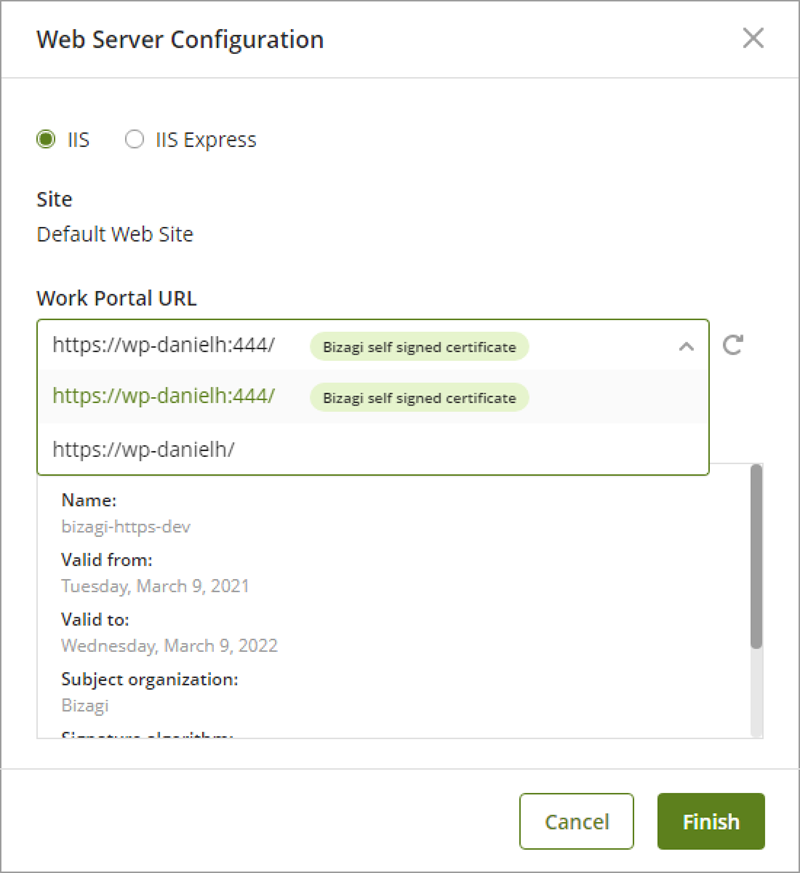
There is a new operator within the actions in a form, is loaded. It allows to perform actions within the form when it has loaded.
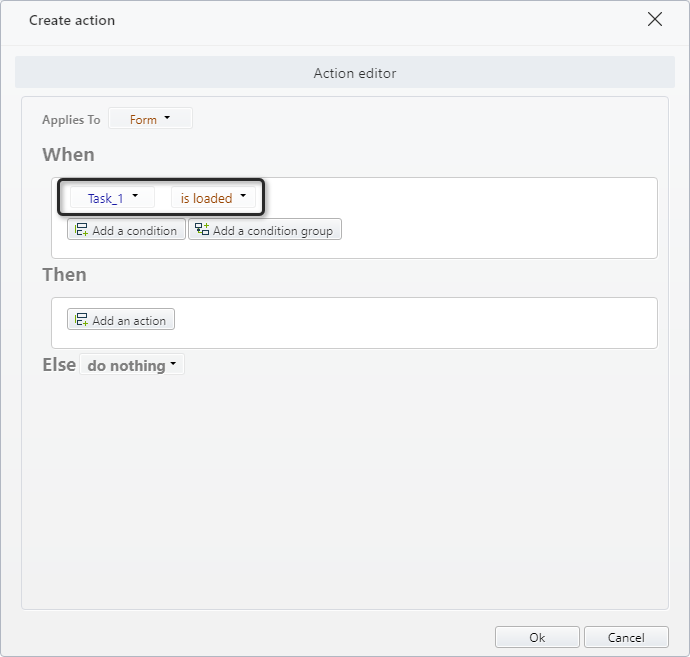
A new control has been created: Ready only, to be used within Forms, in a read-only fashion.
Read only controls can be related to: Boolean, Date, Number, Text, Money.
Now rules contained within Summary forms cannot modify the values of attributes of type XPath. All Summary forms’ attributes are read-only. This prevents rules reused in Summary forms from modifying case values by mistake.
When a rule that modifies attributes is used in a Summary Form, an error message will be shown to the end user in the Work Portal. Refer to this article to learn about this change and how to solve any issues.
A pipeline is a component that allows executing multiple automatic tasks in a specific order. The elements that can be used within pipelines are:
Pipelines can be defined through On Exit Activity Actions. Pipelines are defined in a process context; thus, they can be used within the activities of the process where they are configured.
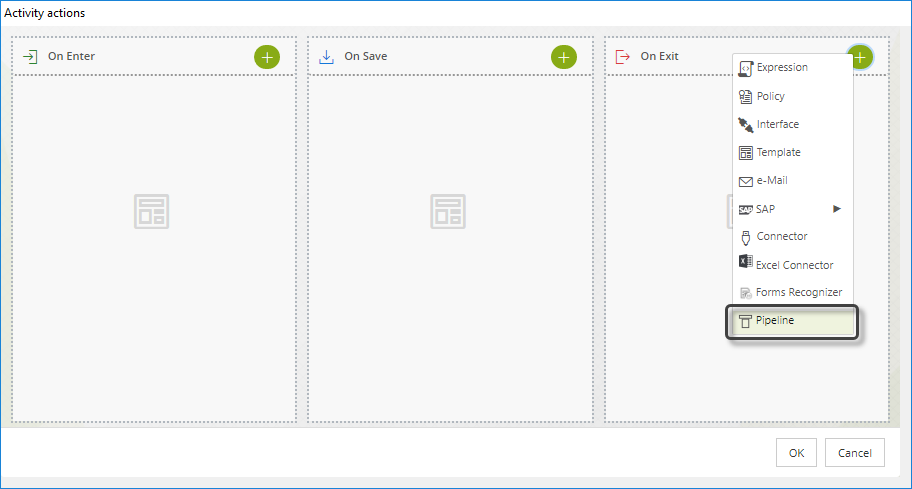
You can now enable the traces when integrating with ECM systems to detect whenever there is an issue during the integration.
Now Bizagi supports the LDAP user synchronization using the SSL, also named LDAPS.
Users can now access Work Portal with one click from their Identity Provider Application HUB, also called the IdP (Identity Provider) Initiated Flow, without the need to register their credentials. This applies to authentication with the SAML 2.0 protocol.

Language system metadata (currencies’ format, dates, abbreviations for days/months, etc.) has been improved to simplify the correction of possible errors.
Bizagi login page has been redesigned. Besides the modern styling and fresh color tones, this new design contains improvements in accessibility, authentication, and site navigation.
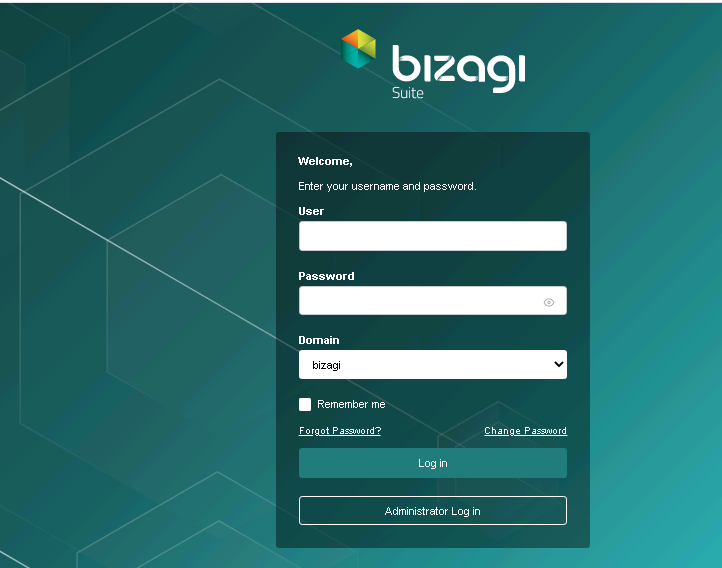
Now, it is possible to hide the currency symbols when adding attributes of type Currency in message templates. A key can be set: HideCurrencySymbolOnMessageTemplate key. These attributes are considered as Float attributes in all messages sent from the project.
For on premises customers the key can be set in true in the Webconfig or in the Scheduler’s config. For cloud customers, a ticket must be created requesting the key.
You can now customize the confirmation message displayed when a user clicks a button within a form. This applies for both form buttons and button controls.
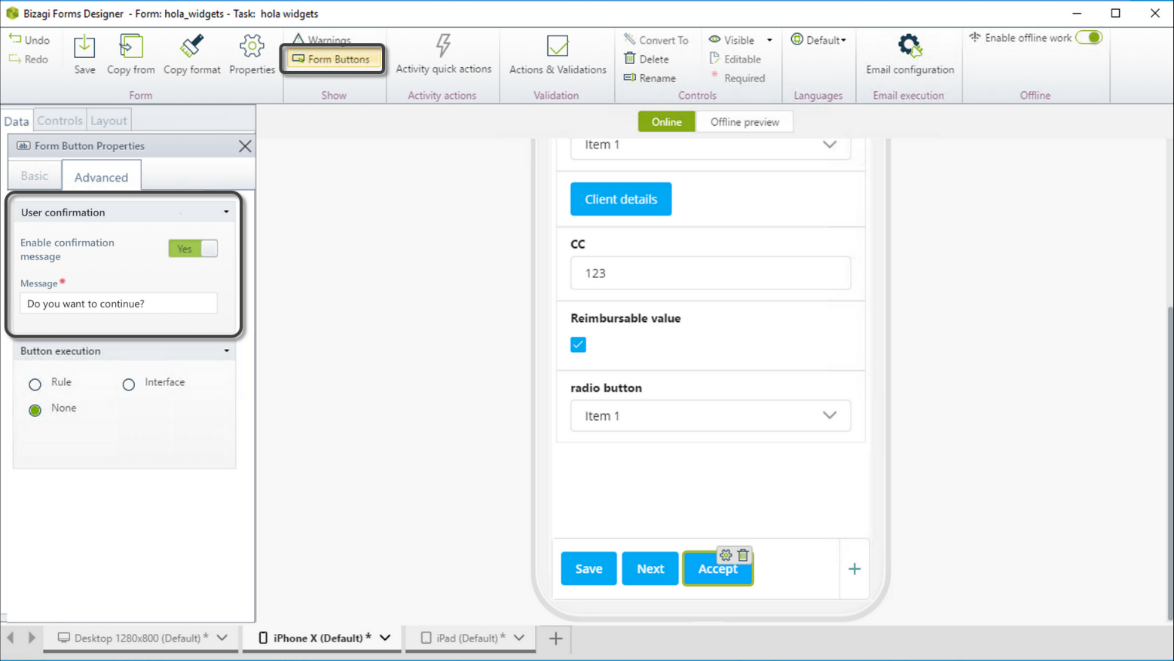
There is a new control property for tables, grouped tables, and columns: Is sortable. It is a Boolean property that defines whether the data in the control can be sorted or not by the end user, or not.

Now, users can use the functions Today() and Now() when defining a date in an Actions & Validations in a form.
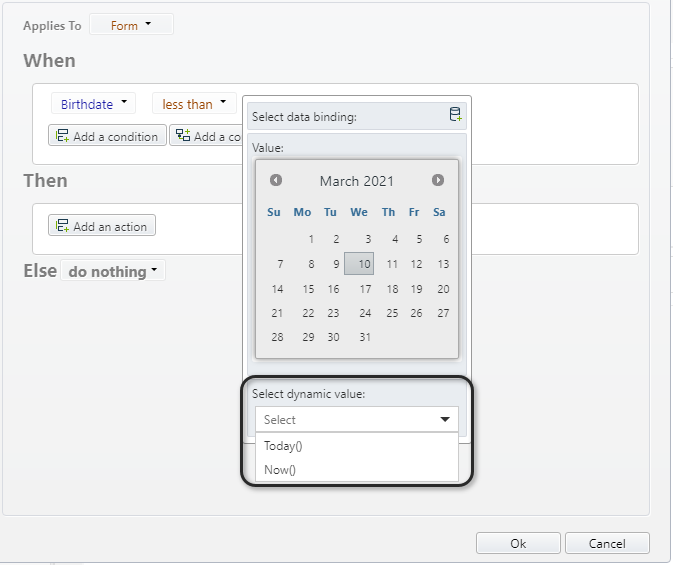
The Working Time Schema wizard has been improved. Users now can use schedules to define the working or non-working days. Additionally, users can create exceptions as holidays and custom days, increasing the level of customization for each Working Time Schema.
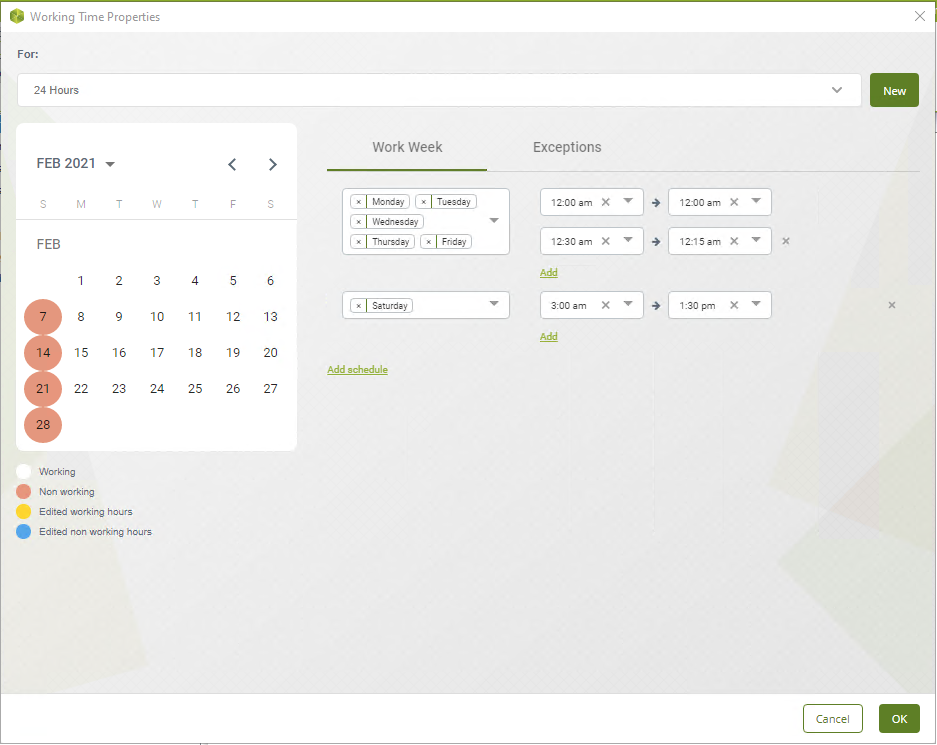

The wizard used to visualize the deployment packages had an interface improvement.
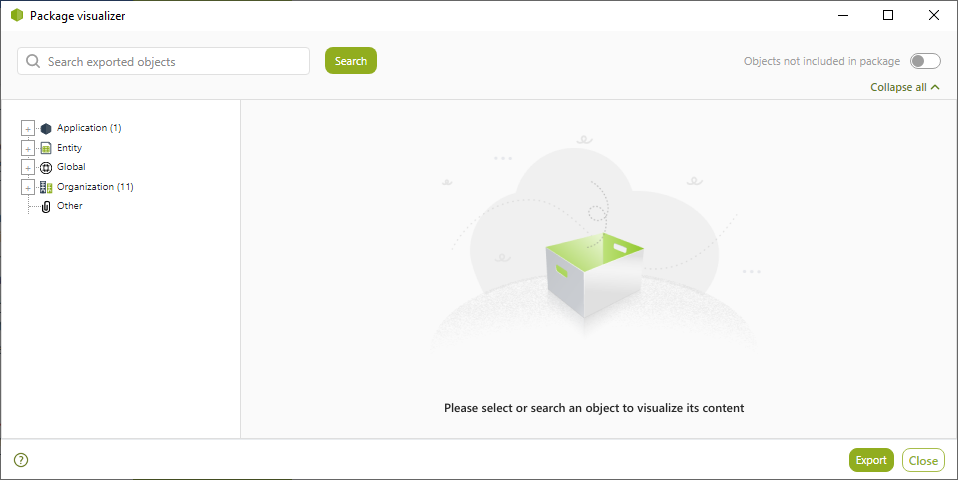
When an authorized user invalidates one or more cases either from the Admin menu, a rule or invoking the method from the SOA Layer, the project can execute a rule to adjust the business data of the invalidated case(s). This rule will be executed after the invalidation and the case will be invalidated after a successful execution of the rule.
The following improvements have been made to the On Premises BPU report:
In the Management Console on premises, the waiting jobs option presents a filter to let you easily find any job. The search can be performed by any of the columns of the list such as name, creation date, case id, process name, etc.
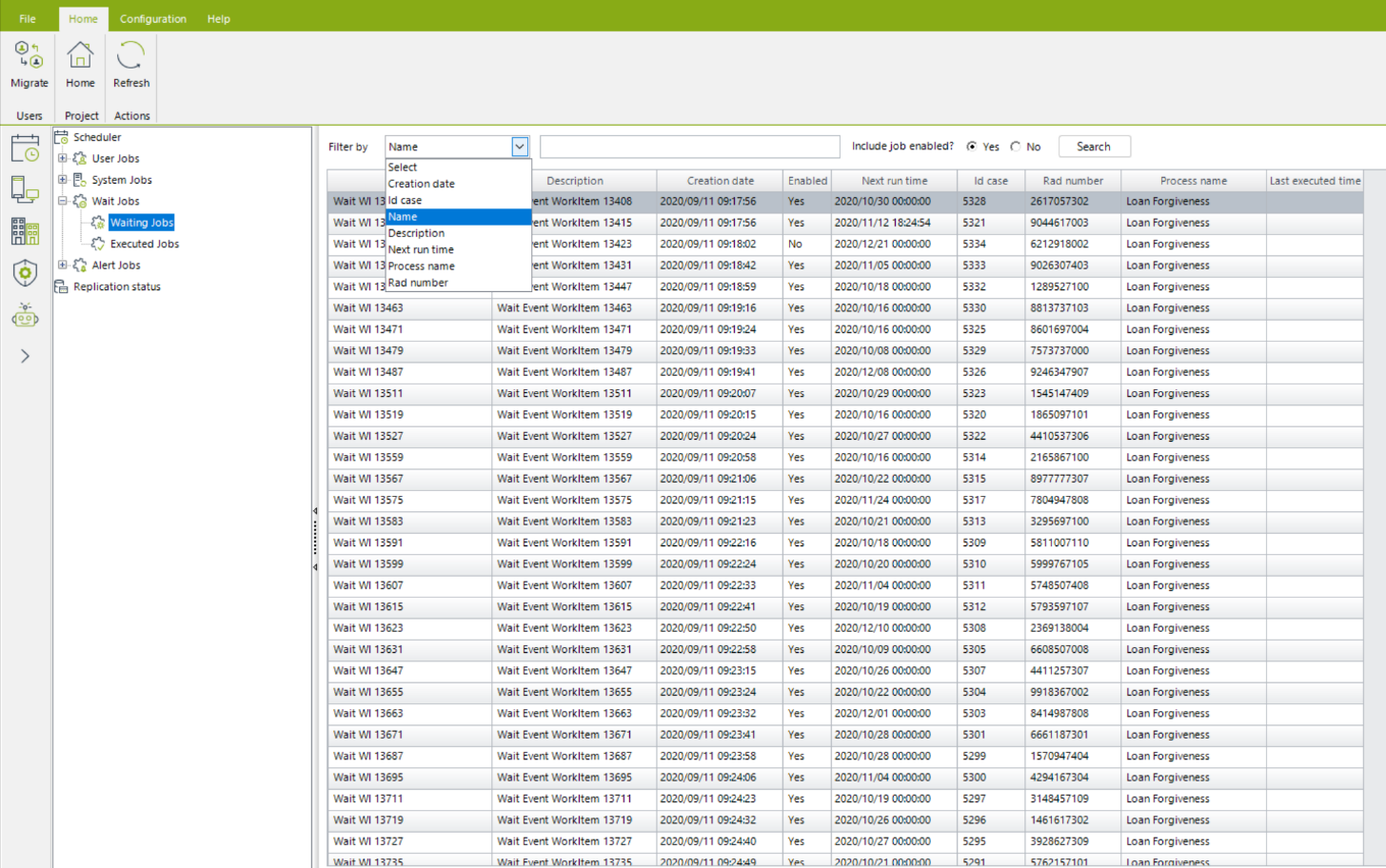
ToString(), PadLeft(), Replace(), and ToUpper().Me.Scope.Commit function, a warning appears indicating that the function should not be used.The following improvement have been applied in the Data Synchronization wizard:
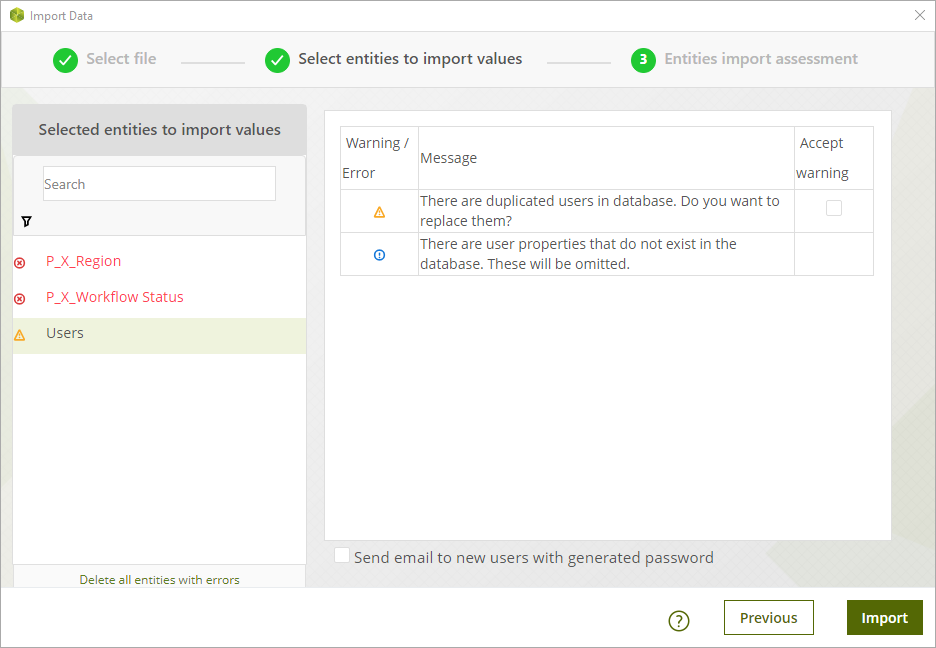
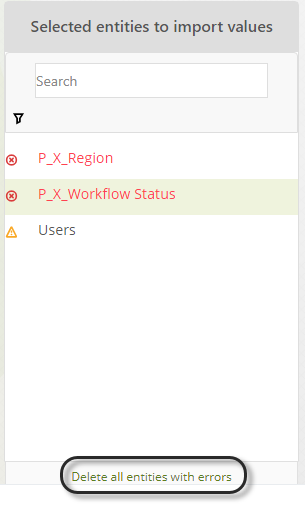
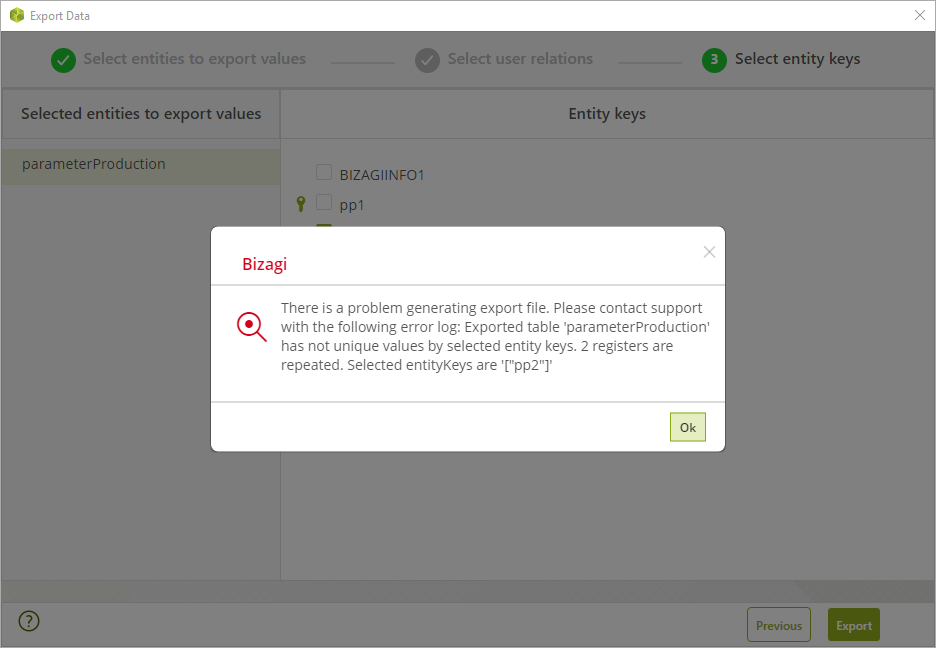
The upload size limit to Bizagi was modified. For cloud environments and for on-premises environments the recommended value is 25 MB. This setting can be configured in the Management Console Web for cloud or in Bizagi Studio.
Now users can select the language of a message template or a document template to match the language of the end user (if it is available), in other words, the language used for the template tags.
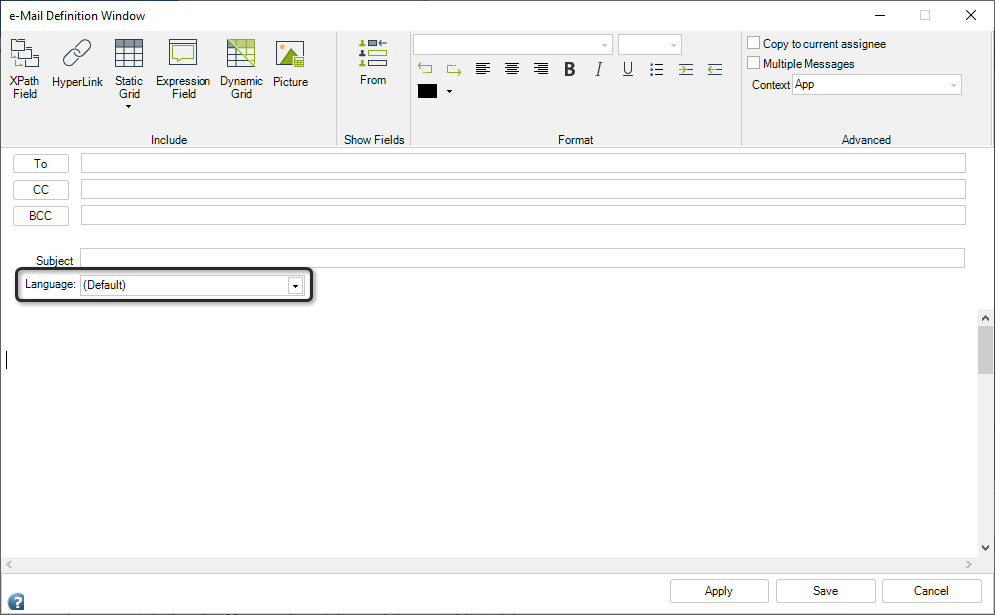
The warning of a checked-out process is now displayed at the start rather that the end of the exportation of a package.
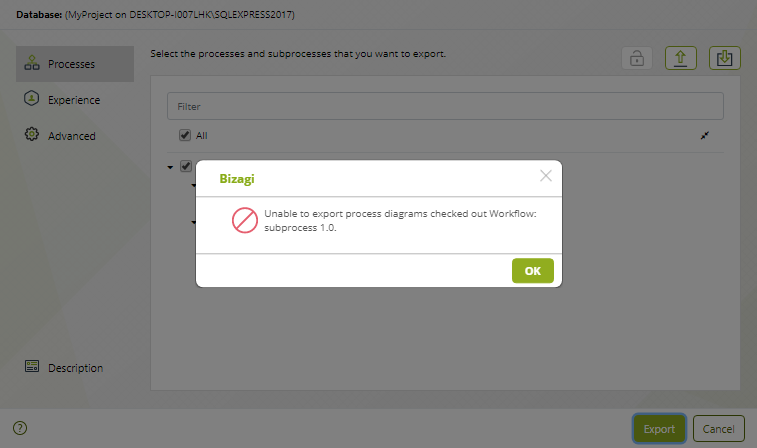
As there is a new proxy configuration available in Bizagi Studio and the Management Console Web (MCW), all HTTP based integration options must use the proxy configuration: Connectors Service, ECM integration, SOA & REST interfaces, etc.
Now Bizagi provides a wizard to configure a proxy compatible with all its products that can be configured for any environment to manage requests of external services.
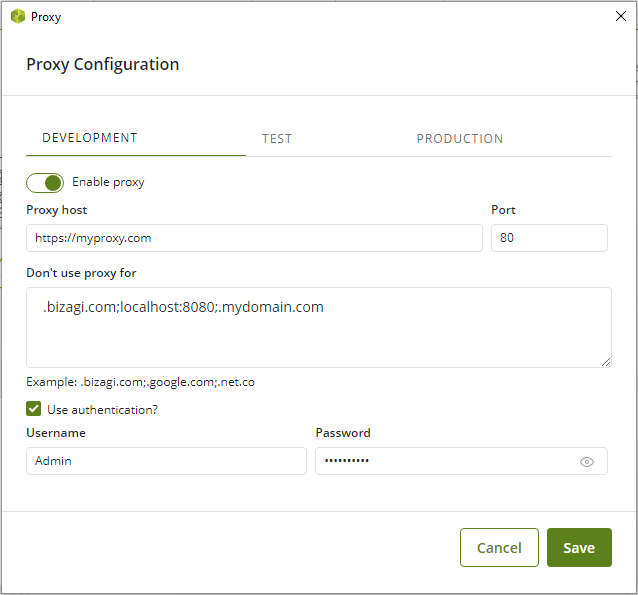
When creating a deployment package, users can set a password to prevent it to be handled. Later, it will be required when importing the package.
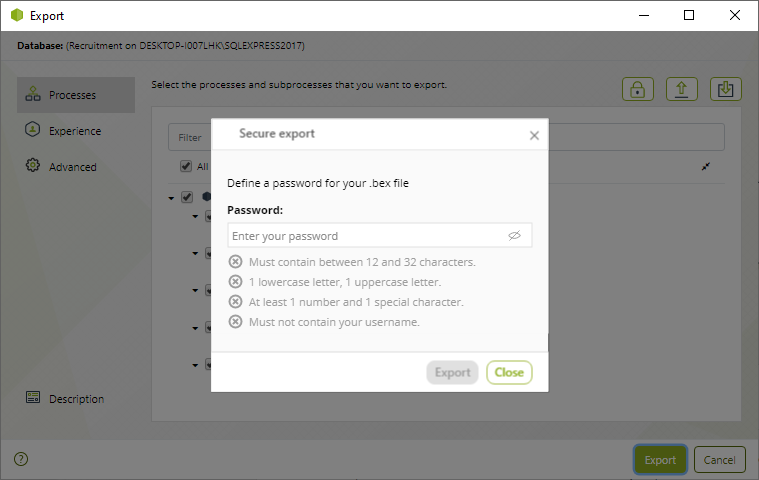
Now the default encryption algorithm is AES.
The Access-Control-Allow-Origin header response is removed and is only sent when a CORS trusted domain is configured in Bizagi Studio.
The Portable Edition improves the way it is extracted to ease finding Bizagi Studio executable file, so users can easily open it and start working. Components are all now included in a folder, so the executable file is listed along other few files and it is easily found.
The option Register operations to the log, for Application, Master, Parameter and Stakeholder entities is now DISABLED by default when an entity is created. If a user wants to enable the log, they must do it manually for each entity.
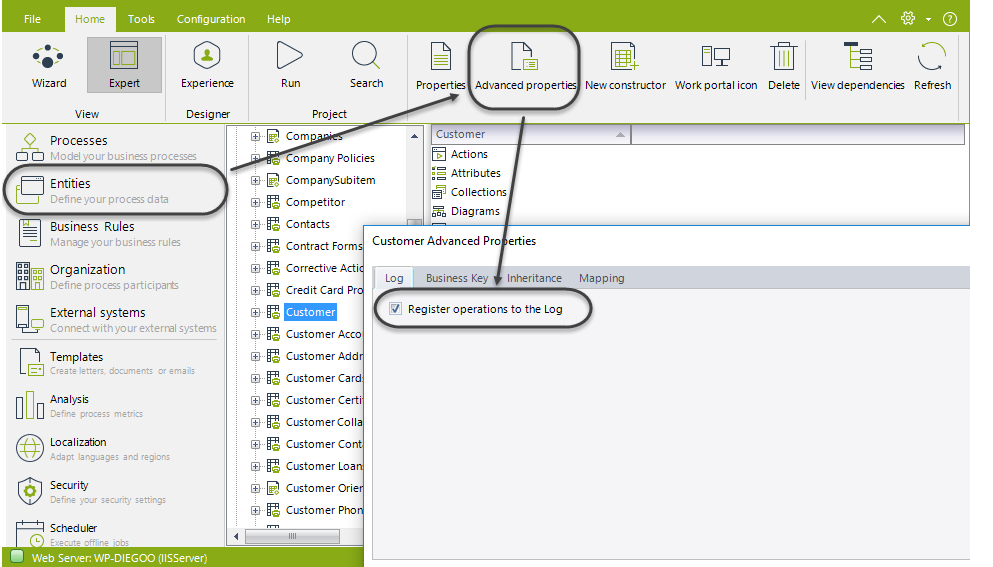
When creating a new attribute, a filter option is displayed in the Attribute Type selection, to ease finding related attributes or default types.
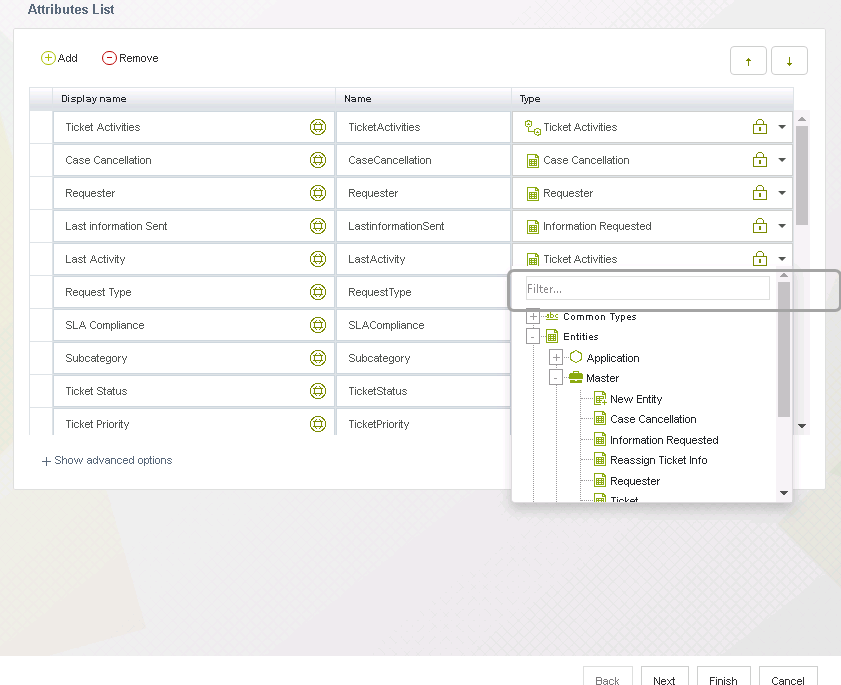
When creating a new project Bizagi now validates that the project’s name doesn’t include reserved words. Existing projects are not impacted when upgrading.
For HTTP requests, there is a header called the Content-Security-Policy, which let users control the resources that are loaded in a page. Now, you can define a custom parameter with this key to control which resources from external systems can be loaded. This key is needed for the execution of widgets that connect to external systems and attended bots.
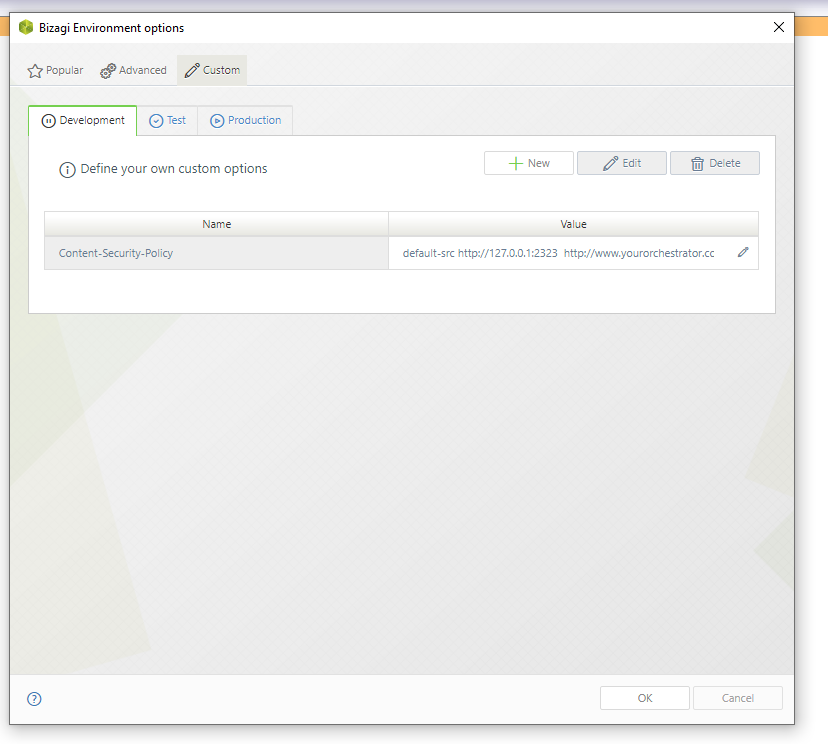
As from this version, we will not support the following operating systems:
We will support for Automation Server:
As from this version, we will not support the following SQL Servers:
A new view included in Bizagi mobile application, called Synchronization errors, enables users to see the tasks that had synchronization problems with the server, when coming back online. Bizagi displays tasks in this view as read-only, and users can retry or edit information saved in them. When online, an cloud-icon will display a red dot on the upper right corner of the app when there are errors.

Now the mobile application displays iOS standard information, such as battery status and time.
The UI-Webview component has been updated to ensure that Bizagi remains available on the App Store.
To improve the user interface in mobile devices, the touchend event logic has been added to the following application’s components: (1) the arrow button that closes the form and returns the user to the previous screen, (2) the button that displays the form’s options (such as Summary), and (3) the Save and Next buttons.
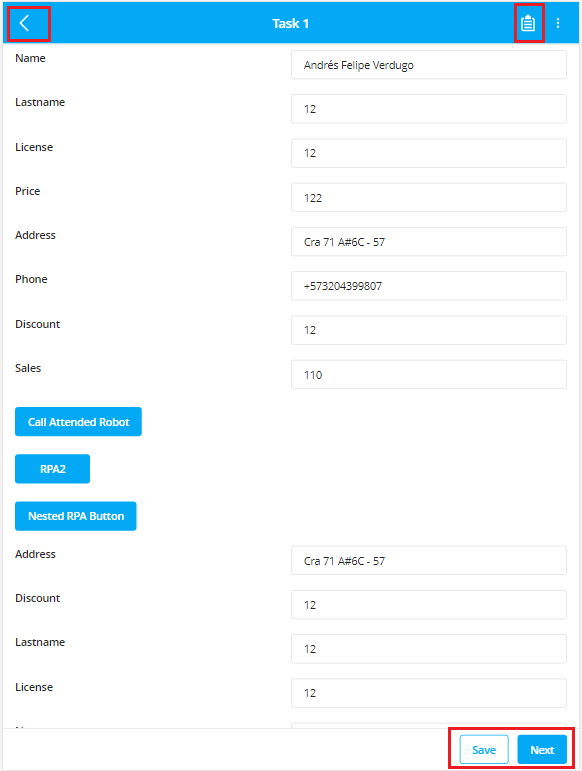
To improve security, now HTTPS protocol is selected by default in Bizagi domains (bizagi.com) when accessing a project through the mobile application.
The visualization of tables in tablets has been improved. You can now define the width of each column in pixels or in percentage.
Additionally, tablets now display more columns than the default four columns.
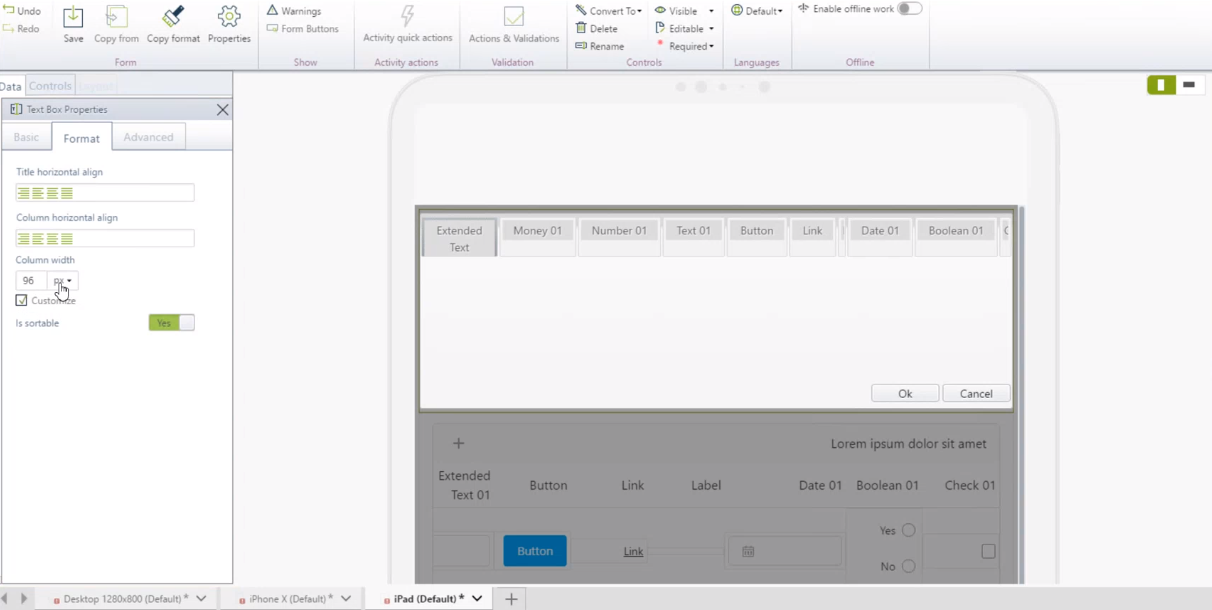

The control Button is now supported in Bizagi Mobile App. This control can be used in offline mode as long as its execution does not require interaction with the server. For example, changing background, fonts, etc.
Now the multi-select control is available in offline forms.
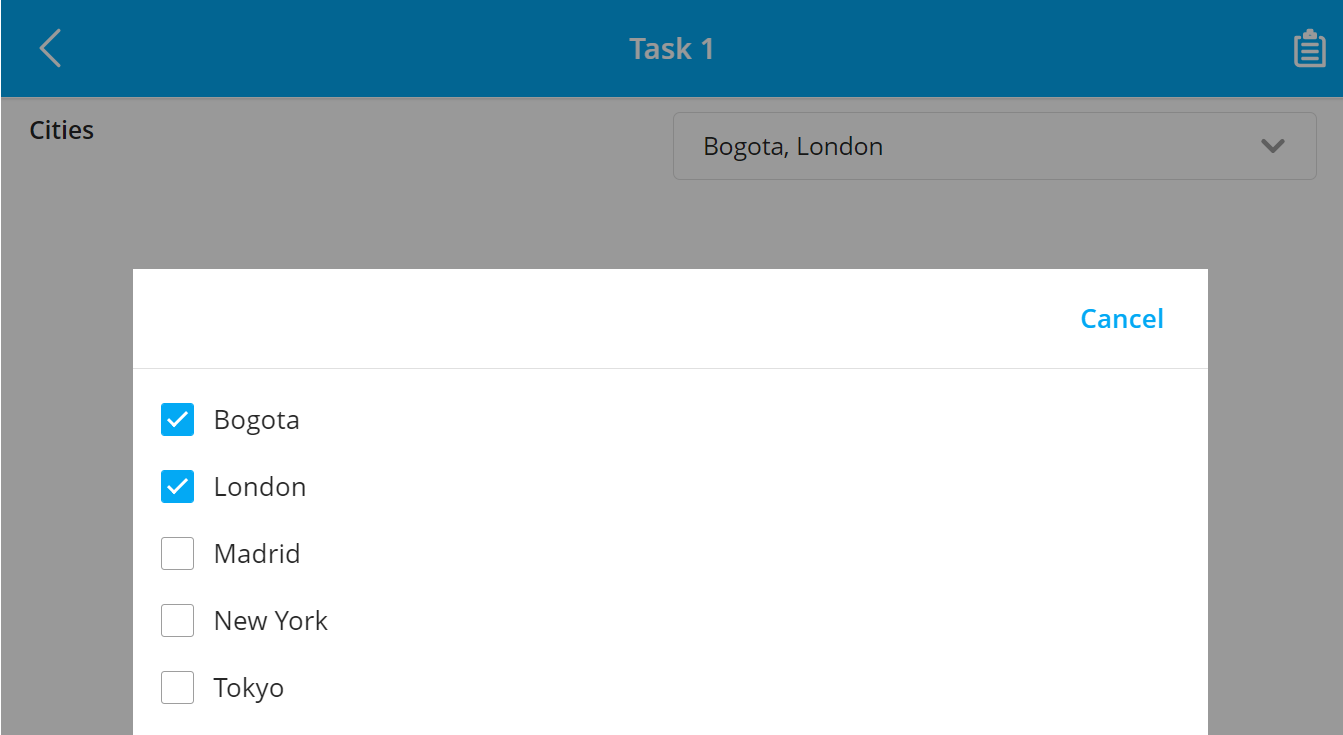
The exclusive property in checkbox yes/no controls in a table is now available for offline forms.
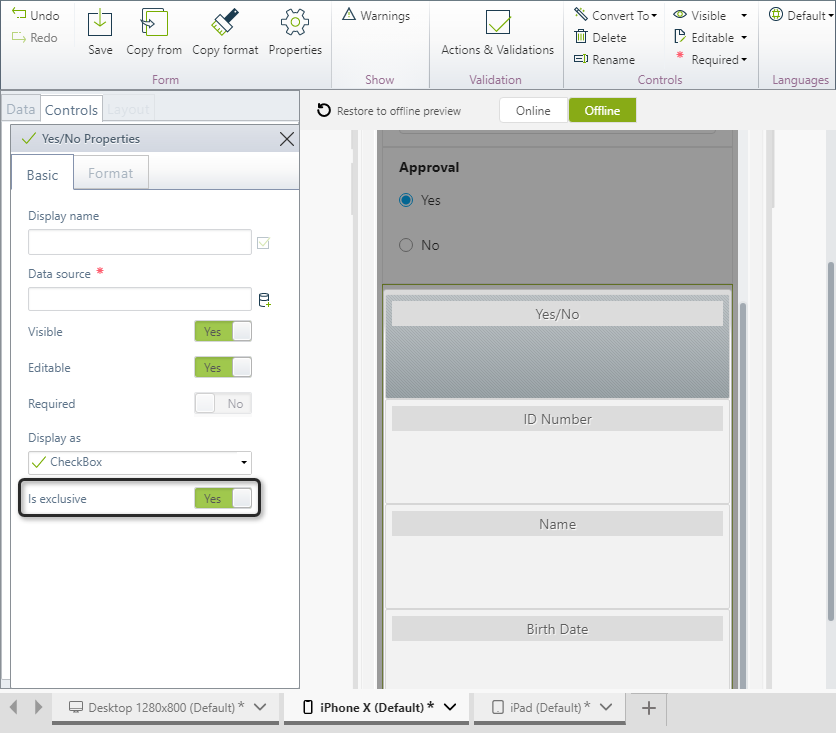
Zero downtime deployment is the capability of deploying processes while your system is running. With this new feature you can have 24 x 7, non-stop solutions.
Implement continuous improvements to your applications, processes, data models, interfaces, or any component of your solution without outages for your end users.
95% of deployment scenarios are covered. The system will warn when a maintenance window is needed.
To enhance the experience of our cloud Enterprise users, the Stakeholder’s synchronization functionality is now available in Studio Collaboration Services (MCW) for development environments.
The tracing module in Management Console Web has been improved with the following features:
Customers are welcome to create a ticket to setup the whitelist of IPs that can access Bizagi Cloud portals. The whitelist applies for all services (Modeler, Studio Collaboration, and Automation).
Customers store report-ready business information in Bizagi’s BI. As a case is flowing, it is easy for developers to identify the moment in time to post data to BI as a central repository, where data is flat, easy to understand and easy to consume.
This centralized repository is enhanced in this version with the inclusion of business keys and time stamps that together enable the ability to update existing records.
Combining BI with Runtime entities you have an innovative and robust way to create reports, having meaningful data stored in a centralized place ready to consume.


The new Smart Inbox lets end users predefine pending tasks in sections of their inbox, to display cases of processes gathered by filters based on business information. For example, set an inbox with cases where the amount of a request is greater than a certain amount.
These Smart Inboxes can be shared to different end users, so they can see the same classification of cases in their inboxes.
By default, all users of the Work Portal can create a Smart Inbox. However, you can define security restrictions, and define who can create Smart Inboxes.
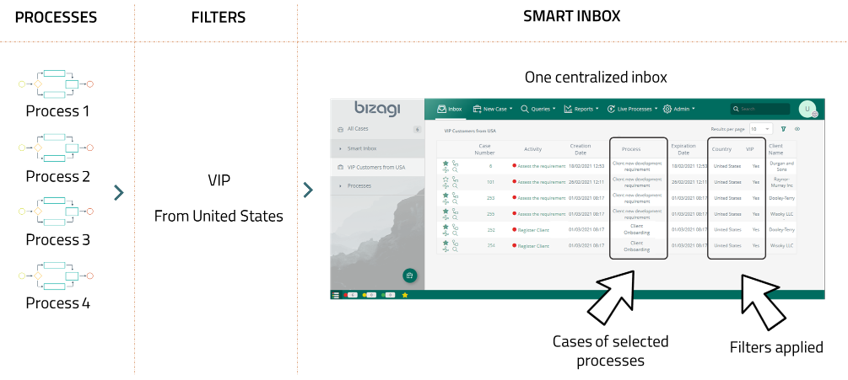
When a user has a new pending task from a new case, it is highlighted in the inbox with a vertical line on the left-hand side.
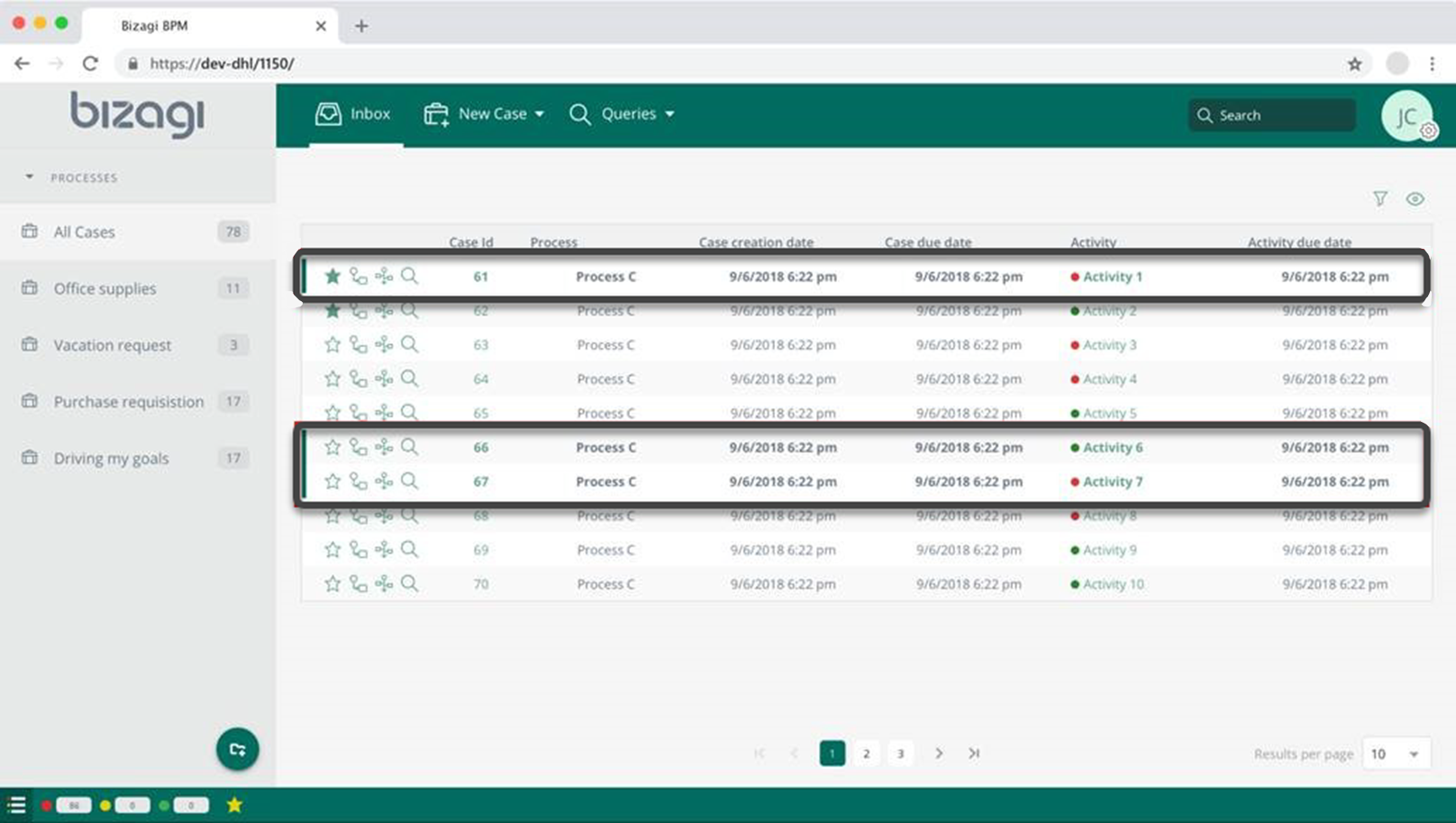
For each Inbox (Smart or regular inbox), users can apply additional filters called Live Filters, clicking the filter icon located at the top-right corner of the Inbox.

You can define a default Inbox (normal or smart) so it is fixed on your left-hand sidebar and when a user logs in, or click the Inbox menu, Bizagi displays the default inbox.
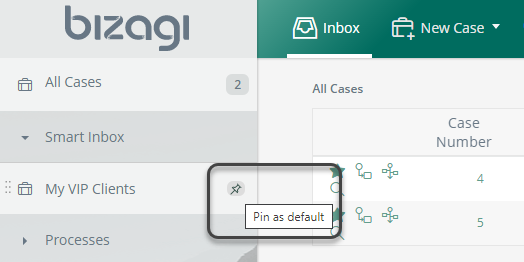
The default Work Portal’s Theme has been updated for an improved and modernized experience.
For new projects the improved look and feel will be used. For existing projects that have customized their theme with a logo or customized colors, such changes will be kept.

Now in the Asynchronous Activities Console in the Work Portal, users will be able to manage the RPA activities that fail. This means they will be able to see and retry those activities that failed in a process.
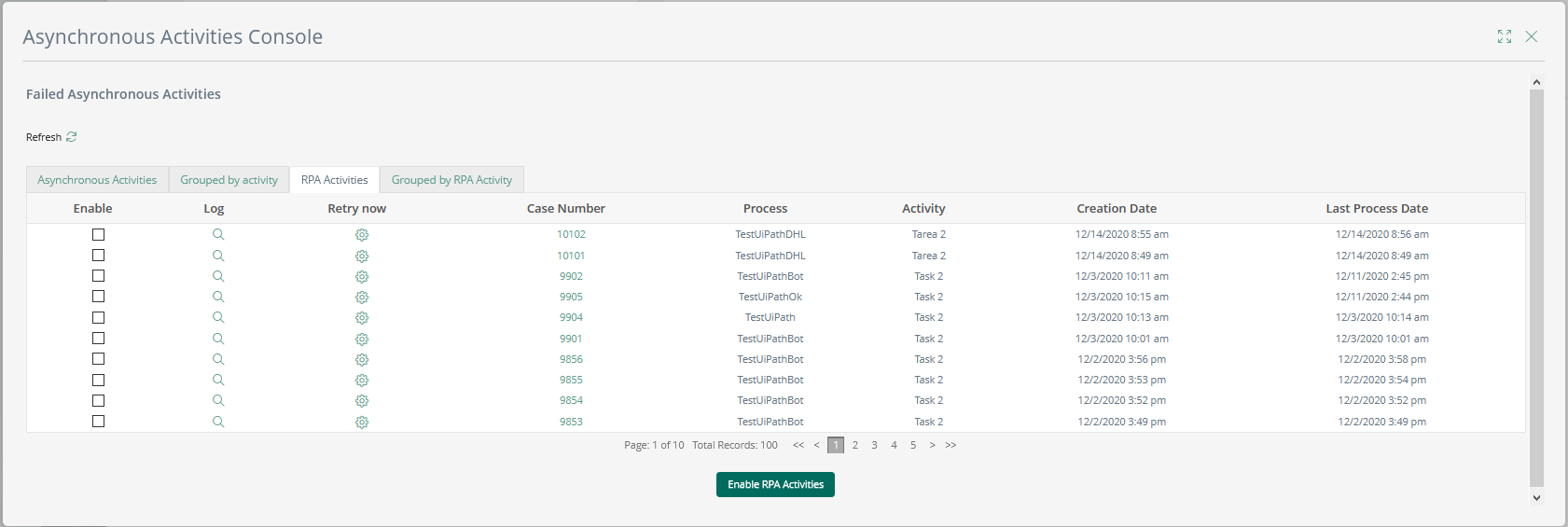
To enhance the experience when using Live processes, the following improvements have been included:
The look and feel of the date control have been improved in the desktop’s Work Portal.
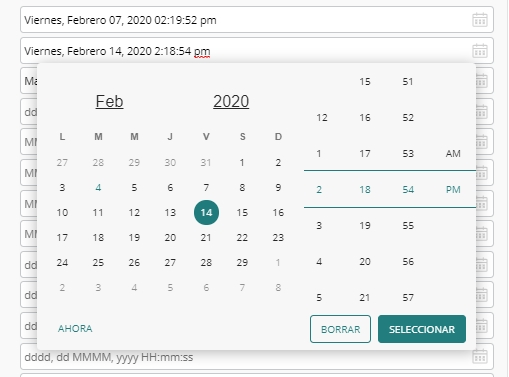
Now when a user prints a form or a collection in the Work Portal, the name of the file will be IDCase_ProcessName for the forms, and the collection name for the collections; allowing the user to have a better control of the forms and collections printed.
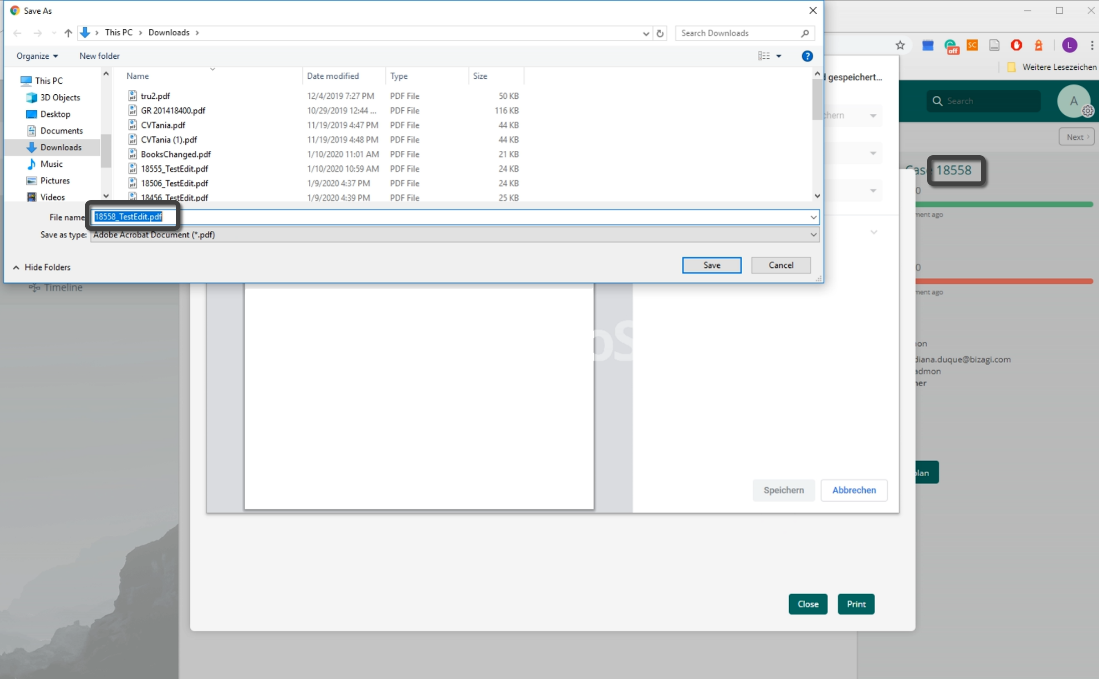
Users now have available the inbox options in the results of a query, this includes the graphic query, the timeline and the case summary.

Now if an activity description is too long, a button appears to show the description in a new screen.
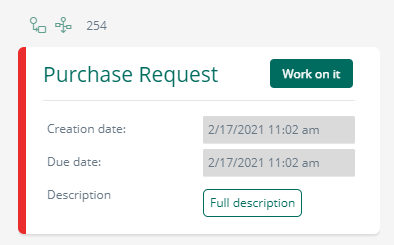

When a Document template is generated and a table is left unmapped, the output will display the “Foreach” tags that have been left empty. The Template must be mapped in Bizagi Studio. Example: [Foreach:Customer] [Name] [Phone] [End]
When a user uploads a picture in their Work Portal’s preferences, said picture can now be deleted.
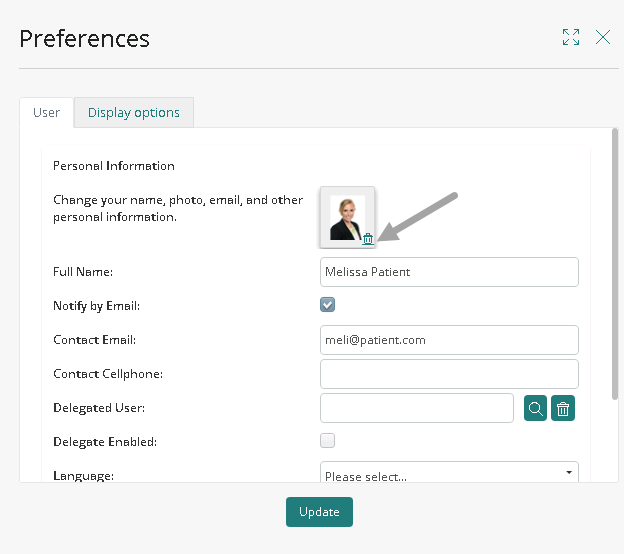
You can configure multiple identity providers associated with the authentication of users for cloud-based services and portals, for example, the Customer Portal, Modeler Services, Studio Collaboration servicers, and AI or BI portals.

A new authentication recovery functionality that activates only the default authenticator (Bizagi Accounts) for all domains is now available.
Automation Services’ Customer Portal now includes a new feature to review the BPUs consumed per environment. The new reports display the consumption per Day, month, yearly or with a custom range. The report is adjusted according to the time range selected.
The list of processes related to the consumption and their BPUs consumption is displayed in these reports as well.

Now, you can perform a Partial or full reset of your environment directly from the Customer Portal.